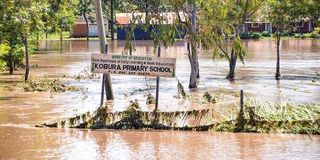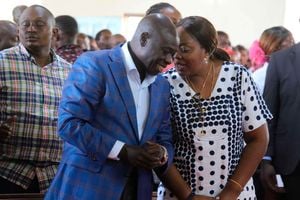Schools reopen on Monday, but hundreds are submerged by floods

Submerged Kobura Primary School in Ahero town, Nyando Constituency.The heavy downpour in Ahero has affected many learning instutions in the region.
What you need to know:
- President Ruto’s move to reopen schools has, however, elicited mixed reactions. “The government should have dealt with restoring school infrastructure, repairing bridges and roads before issuing the order to reopen them,” Ms Beatrice Koech, a resident of Litein in Kericho County, said.
- “How are we expected to release children to cross rivers whose banks have burst due to floods? Which sane parent will allow his young child to use makeshift bridges to cross rivers and navigate through roads that have been cut off?” she posed.
Submerged classrooms, flooded compounds, collapsed ablution blocks and destroyed buildings are some of the scenes that will welcome learners when they report back to school on Monday.
Thousands of learners are also likely to face transportation challenges following destruction of many roads across the country, with bridges that were swept away by floods still in a state of disrepair.
A nationwide spot check by the Nation shows that while many schools are ready to resume learning, there are quite a number that are uninhabitable and pose both health and safety challenges to learners and teachers.
President William Ruto said yesterday that schools will be reopened following advice from the Meteorological Department.
“All parents are now advised, based on the assessment of weather experts and the government, that it is safe for our children to go back to school,” a statement from State House quoted Dr Ruto.
He said the government will release funds to the National Government Constituency Development Fund (NG-CDF) for rehabilitation of schools that have been damaged by the floods. The President last week requested MPs to utilise the kitty for the rehabilitation of schools since the Ministry of Education does not have an allocation for emergency response.
According to a statement released later yesterday by Government Spokesperson Isaac Mwaura, 257 people have so far died as a result of the floods, with 188 others injured.
Mr Mwaura said 54,837 households have been displaced, affecting 293,661 people. Some of the displaced are hosted in public schools. Additionally, 44 cases of cholera have been confirmed.
“Several roads have been rendered impassable due to water overflows and road cut-offs. Strong water currents have also made some roads dangerous for vehicle passage and increased water stagnation is damaging many roads,” Mr Mwaura said.
However, he did not give details of learning institutions that have been affected. Education Cabinet Secretary Ezekiel Machogu last week instructed boards of management of schools to send status reports of their institutions to county education boards. The boards have until tomorrow to submit their consolidated reports.
President Ruto’s move to reopen schools has, however, elicited mixed reactions. “The government should have dealt with restoring school infrastructure, repairing bridges and roads before issuing the order to reopen them,” Ms Beatrice Koech, a resident of Litein in Kericho County, said.
“How are we expected to release children to cross rivers whose banks have burst due to floods? Which sane parent will allow his young child to use makeshift bridges to cross rivers and navigate through roads that have been cut off?” she posed.
In Bomet County, especially in Chepalungu and Sotik constituencies and lower parts of Bomet East, Kipranye, Kaplele, Kipkoligo, Itembe,Chebirir, Kapkwen and Cheboingong are some of the affected schools, with toilets overflowing with water.
At Kisabita, Sigowet and Itembe primary schools in Chepalungu, pit latrines have collapsed.
“It poses a huge risk to the learners as schools reopen next week,” Bicoty Kenduiywa, a parent said.
All the 14 latrines at Mathenya Day Mixed Secondary School in Ngobit Ward, Laikipia County, have been destroyed.
High water table
“We don’t have an immediate solution to this problem since digging new ones is not practical at the moment due to the high water table resulting from the heavy rains,” said Mr Felix Hamadi, the county director of education.
He said that ablution facilities in 42 other schools had been destroyed. At Nanyuki Garrison Primary and Junior Secondary School, half of the toilets are unusable. Other affected learning institutions include Mutirithia Primary and JSS, where the entire school compound remains under water. Transport along the Nanyuki-Naibor-Il Polei road poses challenges to students who will be heading to Dol Dol Secondary, Il Polei Secondary and St Francis Girls High.
The construction company contracted to upgrade it to bitumen standards in November 2021 at a cost of Sh596 million left after doing only 10 per cent of the work.
Parents at Kimbimbi Primary in Kirinyaga County expressed apprehension about taking their children back to the school where many essential facilities have collapsed. The road leading to the school is also impassable.
In Nyando, Kisumu County, at least 16 schools are still submerged, according to the County Commissioner, Benson Leparmorijo. Over 40,000 households have also been displaced after River Nyando burst its banks last weekend. The affected institutions are Kibarwa, Nyamasao, Oseth, Ogenya, Nyamrundu, Odienya primary schools and Kandaria, Ombaka and Nduru secondary schools.
Ombaka Primary hosts 386 displaced households.
“We are worried that the sanitation facilities could be overstretched when schools reopen on Monday,” Mr Neto Awich, a local administrator, told the Nation.
In Kakola Ombaka sub-location, increased backflow from Lake Victoria has destroyed over 600 acres of farmland. In Central Bwanda sub-location, assistant chief Celine Oywa said most of the affected residents have camped at Ugwe Primary as they wait for the floodwaters to subside.
In Uasin Gishu, the County Education Board is carrying out an assessment of the damaged schools to be tabled tomorrow.
“There is no precise number of schools that have been damaged by the floods, but what I know is that some toilets have been destroyed after they were submerged while damaged infrastructure will require renovation,” said Dr Edison Nyale, Uasin Gishu County Commissioner.
Several roads, especially in Kerio Valley, have been cut off by landslides. Interviewed parents said the rains will subject day school learners to a lot of challenges.
“Day scholars will be hard-hit considering that they will be required to cross flooded rivers and damaged infrastructure which exposes them to risks,” said Ms Mary Chepkemboi from Cheptiret in Uasin Gishu.
On the shores of Lake Turkana, some schools like Merier Primary and Merier Early Childhood Development Centre were affected by surface runoff and the swelling lake that left toilets and some classrooms destroyed.
In the far-flung areas, County Education Director Henry Lubanga, however, warned that accessing some schools in Loima, Turkana West and Turkana North sub-counties, is always risky whenever seasonal rivers flood.
At Cheptulel Boys High in West Pokot County, a school that has remained closed for the last year after bandits vandalised classrooms, renovations by the Kenya Defence Force (KDF) are ongoing.
This is where the then-Chief of Defence Forces Francis Ogolla spent his last moments shortly before a chopper ferrying him and other military personnel crashed on the border of West Pokot and Elgeyo-Marakwet counties. Learners from the school have been studying at Surumben Primary in Masol, more than 50 kilometres away, where they took refuge. Chesta Girls High principal Patricia Nandi Khagai said they were not adversely affected and will just clean up the classrooms.
In Trans Nzoia County, FK Primary in Kwanza Sub-County is being used as a distribution centre of humanitarian aid to victims of floods in the area. In Busia County, at least 14 primary schools and one secondary school Bunyala South ward in Budalang’i are still flooded. Education Director James Ekalyio said about 10,000 students risk missing out on learning.
The affected primary schools include Bukoma, Maduwa, Bulwani, Budalaa, Musoma, and Lunyofu. Bukoma and Namabusi secondary schools in Budalang’i are inaccessible. In Teso North Constituency, Amoni, Kaejo, Kapkuyi, Kajei Primary schools, Kamolo Secondary School and Kolanya Girls are also submerged.
Ten classrooms at Sikinga Primary School in Nambale have had their roofs blown off by strong winds.
Reporting by David Muchunguh, Vitalis Kimutai, Geoffrey Ondieki, Mwangi Ndirangu, George Munene, Victor Raballa, Barnabas Bii, Oscar Kakai, Sammy Lutta , Evans Jaola and Shaban Makokha





